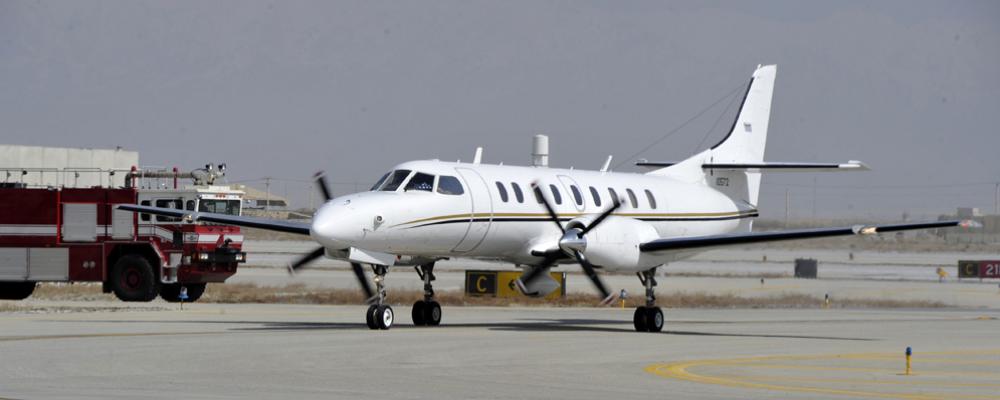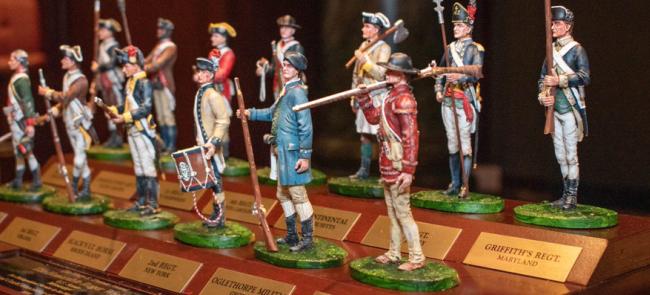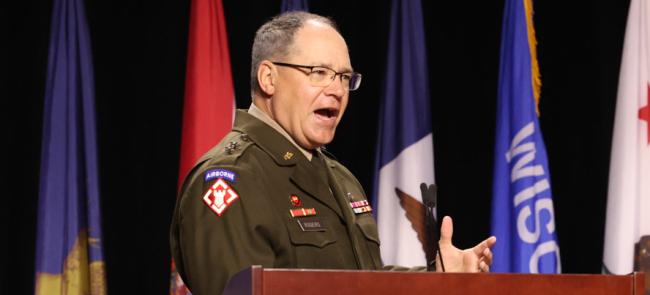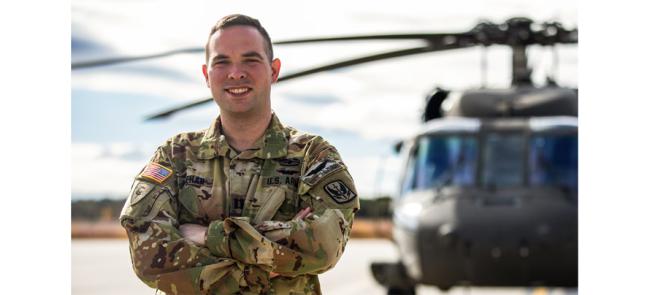
A Fleet in Need
Three years ago, the last of the North Carolina Air National Guard’s C-130 Hercules cargo planes departed Charlotte Air National Guard Base, marking the end of a mission that spanned more than four decades.
The 145th Airlift Wing officially marked the end of its conversion to the C-17 Globemaster III in October, ending a process that spanned three commanders. Officials say the new aircraft provide the unit with more of a global reach and a secure future, coming as the Air Force looks to shrink its C-130 fleet, likely at the expense of Guard units.
But the transition has not been easy. It required a change in culture for a unit, like other Guard C-130 wings, that loved its Hercs. Meanwhile, the process still has a few loose ends, as the unit continues to train personnel and waits on lagging construction projects.
“The C-17 has literally worldwide capability,” says Lt. Col. Robert G. Gatti, the wing’s chief of plans and the officer in charge of the conversion. “The possibilities for this wing and its airmen are only limited by the minds and creativity of planners, and, of course, the almighty dollar.”
The 145th has more than 1,600 airmen, most of whom do not pilot the C-17s but rather maintain them or play other support roles. But like any Guard flying units, the wing derives its identity from the iron on its tarmac.
And for long as anyone in the wing can remember, it was the propeller-driven C-130. That made the conversion a tough sell at first, admits Col. Brian S. McCullough, the commander of the 145th Maintenance Group.
“We were flying C-130s for about 40 years here in Charlotte,” he says. Some maintainers had spent entire careers on the latest of those planes, which began arriving in the early 1990s.
Rather than move to a new aircraft, some of the wing’s airmen simply moved on, transferring to the 165th Airlift Wing in Savannah, Georgia, or other Guard units still flying the C-130.
Most airmen stayed. But not all shared in the excitement when the first C-17s arrived in the spring of 2018, amid a ceremony involving local dignitaries and state leaders.
“We take pride and ownership of the planes,” McCullough says. He described the C-130s the wing gave up as having “Armor All-ed tires and a floor you could eat off of.”
In contrast, the unit’s first C-17s were older than many of the C-130Hs they replaced, coming to the unit from active-component units. They were also not nearly as well-maintained.
Active-component planes have a bad reputation with Guard mechanics. While Guardsmen can spend a career working on the same plane, their active-counterparts change jobs every two or three years. As result, Guard maintainers take more of a long-term view of aircraft upkeep.
“The [C-17s] came with their own set of active-dutyisms. They were legal by active-duty standards,” he says. “We’ve been working to get them up to the Guard standards.”
It’s been a team effort, McCullough says, involving other units in the Guard C-17s community, which includes wings in Alaska, Hawaii, Mississippi, New York, Tennessee and West Virginia. “Folks have been bending over backwards to help us,” he says.
That assistance also has included other units allowing North Carolina airmen to visit and shadow operations and technical experts going to Charlotte to share their advanced knowledge of the C-17. Active and reserve units have also been helpful, McCullough says.
The 145th will not likely get to return the favor to another new Guard C-17 unit anytime soon. Boeing stopped manufacturing the aircraft in 2014 and the Air Force C-17 fleet seems set as currently constituted.
When you bring a new mission with new requirements, sometimes change is difficult to achive.
—Lt. Col. Robert G. Gatti, the chief of plans of the 145th Airlift Wing
THE NEW AIRCRAFT have grown on unit members, McCullough says. “They are proud to be part of the C-17 community and the C-17 mission.”
“Once the planes arrived on base many folks started to understand just how dramatic the mission change was, and then they got behind the changes,” Gatti says. “Leadership has done a great job of gaining buy-in from all the NCANG from the operators flying the planes to the comptrollers filing the vouchers — everyone is proud of the mission we execute worldwide.”
C-17s are larger than the C-130Hs the unit once flew. They carry more cargo (170,900 pounds vs. 42,000 pounds) can go faster (518 mph vs. 366 mph) and require a smaller crew. It can carry an M1 Abrams main battle tank, three combat-ready Stryker vehicles or 10 Humvees.
The planes are also more dependable. The wing no longer needs to fill cargo holds with spare parts, McCullough says. Instead, they can depend on a worldwide network of C-17 support that was not available to C-130 crews.
In Charlotte, where the 145th is co-located with Charlotte-Douglas International Airport, evidence of the conversion can be seen not only in the larger planes, but in the constant construction that has occurred over the last few years.
More than 30 construction projects have been undertaken as part of the conversion, with a total cost over a billion of dollars, Gatti says.
The wing was assigned eight C-17s. But amid the continuing construction, two of the birds have been stationed at the 167th Airlift Wing, another Guard C-17 unit, in Martinsburg, West Virginia.
Meanwhile, the unit added a new operations building, a ramp expansion, new hydrant and refueling system, a fuel-cell hangar and a simulator facility, among other facilities. Some of the construction delays have been caused by the ongoing COVID-19 pandemic, officials say.
In addition to the physical differences between the two aircraft, Gatti says one of the biggest changes was to the unit culture and mindset.
The C-130 is an intratheater aircraft, meaning it often provides direct support to service members on forward operating bases or within areas of operation. The C-17, by contrast, is an intertheater aircraft, able to crisscross the globe with the help of aerial refuelers.
For example, in a C-17, members of the 145th can fly to Afghanistan in one day with air refueling. The same trip would have taken a week or more in a C-130H. But the C-17 can also off and land on austere airfields as short as 3,000 feet.
“C-17s are worldwide deployable at all times, and the crews must be, too,” Gatti says. “The mindset where the base ramped up to a squadron-wide deployment is no longer a valid model and training must occur year-round instead of just in time.
“Trying to change a culture is a delicate situation and many people are established in their way of doing things,” he adds. “When you bring a new mission with new requirements sometimes change is difficult to achieve.”
We're developing our skillset and knowledge. I'm very proud of that.
—Col. Brian S. McCullough, the commander of the 145th Maintenance Group
THE NEW CAPABILITIES were on full display last year, when the wing, for the first time in its history, provided the aeromedical evacuation channel between the United States and the wars in Iraq and Afghanistan. The wing flew 166 sorties over four months, transporting 743 patients from the front lines to stateside medical centers.
The aeromedical evacuation mission was one of many the wing undertook amid its conversion.
While the unit transitioned to new aircraft, retrained its airmen and transformed its home base, airmen continued to support state, national and global missions, providing relief during several hurricanes, ongoing support to warfighters, and numerous other domestic and overseas missions.
In 2018, the 145th deployed to nine states and 16 countries. In 2019, the reach expanded across six continents, including Antarctica, with missions in 14 states and 15 countries.
All the while, the unit either retrained existing airmen or recruited new ones from across the components. Gatti says the unit has doubled its number of pilots, with the transition from a prop plane to a turbo jet providing a huge boon to recruiting.
“On the civilian side, airlines and cargo companies’ No. 1 desire is for pilots with this type of experience since this is most similar to their aircraft operations,” he says. “Many of the youngest pilots are excited for the opportunities that will become available in the civilian sector due to the opportunities and experience they will gain flying the C-17.
“Additionally, the C-130 had a crew position of navigator that is not required in the C-17,” Gatti adds. “Most of these officers were retrained as pilots and now have the ability to pursue pilot opportunities on the civilian side.”
For pilots, the transition to C-17 required at least a three-month long course at Altus Air Force Base in Oklahoma, followed by six months on orders to fly as often as possible. Gatti refers to that period as “seasoning” for the pilots as they adjust to the new aircraft and new missions.
The wing’s maintainers also had to be retrained, becoming familiar with a more advanced flying machine.
For McCullough, the conversion to the C-17 has marked the end of a decades-long wait.He joined the 145th in 1994, amid rumors the unit would transition to the C-17 from its aging fleet of C-130Bs.
Several wing facilities built during that time were constructed with the C-17 in mind, including the wing’s maintenance hangar. A second remains under construction.
“The rumors were floating around,” McCullough recalls. “But instead, I helped bring in our C-130H aircraft.”
Decades later, McCullough helped say goodbye to those aircraft and is now working to set up the foundation for the wing to carry on with the C-17.
“That’s the exciting part for me,” he says. “We’re new to the game. We’re developing our skillset and knowledge. We’re building that now, those subject matter experts, those go-to people. I’m very proud of that.”
Drew Brooks can be reached at 202-408-5885 or [email protected].
AT A GLANCE
C-17 Globemaster III
MISSION: Intertheater cargo & troop transport
PRIMARY MANUFACTURER: The Boeing Company
PRODUCED: 1991-2015
ENTERED AIR FORCE SERVICE: 1995
ENTERED GUARD SERVICE: 2005
ALLIED USAGE: Australia, Canada, India, Kuwait, Qatar, United Arab Emirates, United Kingdom
PRIMARY VARIANT: C-17A
LENGTH: 174 feet
HEIGHT: 55 feet, 1 inches
WINGSPAN: 169 feet, 10 inches
POWER PLANT: Four Pratt & Whitney F117-PW-100 turbofan engines
SPEED: 450 knots (518 mph)
RANGE: Global with in-flight refueling
CARGO CAPACITY: 102 troops/paratroops; 36 litter and 54 ambulatory patients and attendants; or 107,900 pounds of cargo (18 pallet positions)
CREW: Three (two pilots and one loadmaster)
Source: Air Force



